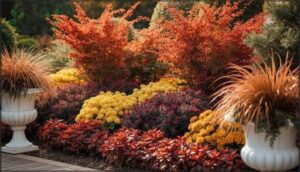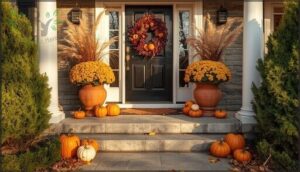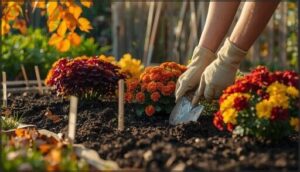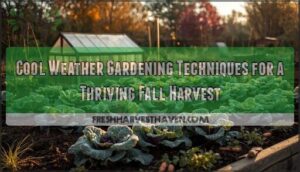This site is supported by our readers. We may earn a commission, at no cost to you, if you purchase through links.
Your garden doesn’t have to fade when summer ends. Fall brings a palette of burnt oranges, deep reds, and golden yellows that can make your outdoor space even more striking than it was in July. The cooler temperatures and consistent moisture actually give you an advantage—plants establish roots faster, and you’re not battling the summer heat.
Whether you’re working with a full yard or a few containers on your porch, the right combination of hardy mums, ornamental grasses, and seasonal textures creates displays that last well into November. Smart plant selection and simple design strategies turn autumn into one of your garden’s most rewarding seasons.
Table Of Contents
- Key Takeaways
- Creative Fall Garden Design Ideas
- Best Plants for Fall Gardens
- Inspiring Fall Container Gardening Ideas
- Decorating Outdoor Spaces for Fall
- Essential Fall Garden Planting Tips
- Frequently Asked Questions (FAQs)
- What are the best Fall Garden ideas?
- How do you dress up a garden for fall?
- How do you make a fall garden look more beautiful?
- What can you put in a fall garden?
- What are some easy landscaping ideas?
- What plants are a good fall flower?
- What month do you start a fall garden?
- What should you plant in your garden in the fall?
- What not to plant in the fall?
- What are the colors of the fall garden?
- Conclusion
Key Takeaways
- Fall gardening actually offers advantages over summer—cooler temperatures and consistent moisture help plants establish roots faster, making autumn one of the most rewarding seasons with displays lasting into November.
- Strategic color design matters: use analogous palettes (reds, oranges, yellows) for harmony, complementary colors (purple asters with yellow mums) for drama, or monochromatic schemes for subtle sophistication, all anchored by dark foliage.
- Plant selection should prioritize hardy fall performers like chrysanthemums, ornamental grasses, and native wildflowers that draw 37% more pollinators than cultivars while providing nectar through migration season.
- Container gardening extends fall color to any space by layering textures—pair mums with trailing verbena, use pumpkins as biodegradable planters that boost soil moisture by 25%, and mix ornamental peppers with cabbage for 7-10 weeks of display.
Creative Fall Garden Design Ideas
Fall garden design is all about making the most of autumn’s natural beauty while adding your own creative touches. You can play with color palettes, textures, and seasonal elements to transform your outdoor space into something that feels both fresh and cozy.
Here are some design approaches that’ll help you craft a fall garden worth showing off.
Designing With Autumn Color Schemes
With cooler days comes the opportunity to paint your garden in autumnal color. Here’s how to build a striking color palette:
- Analogous palettes blend neighboring hues—reds, oranges, yellows—for harmony
- Complementary colors like purple asters with yellow mums create drama
- Monochromatic schemes layer varied tints for subtle sophistication
- Dark foliage plants heighten bright blooms
Consider adding spirea shrubs, which offer beautiful fiery shades in the fall.
Container colors matter too—white or gold heightens your fall garden color schemes beautifully.
Incorporating Rustic Elements and Textures
Natural materials like weathered wood, stone, and a bale of hay bring grounded warmth to your space. Birch log containers and vintage finds add character without fuss. Textural diversity matters—pair feathery grasses with sculptural seed pods for visual interest.
Embrace asymmetry; rustic garden elements look best when they feel organic, not overly arranged. To boost the natural feel, consider using native plants that thrive in local conditions. These touches boost garden durability while creating rustic decor that feels authentically seasonal.
Creating Monochromatic Fall Gardens
A single hue repeated across varying values creates harmony with calming effects. Monochromatic look design lets you explore foliage texture and autumnal color through tints and shades—think amber grasses paired with golden mums.
The Munsell system quantifies these choices, ensuring precision in fall garden ideas. Hue saturation shifts with light, so choose foliage plants that adapt through seasonal shifts, maintaining visual interest as your fall garden design evolves naturally.
Enhancing Curb Appeal With Seasonal Displays
Your curb appeal can jump by 4% to 5% when you nail your fall display. Start with Foundation Plants like evergreens to anchor the space, then add Symmetrical Plantings of mums or ornamental grasses near your door.
Crisp Edges around beds signal care, while Seasonal Wreaths and pumpkins boost Color ROI.
These fall garden ideas for porch layouts turn entries into buyer magnets—or simply make neighbors pause.
Best Plants for Fall Gardens
Fall gardens shine when you choose plants that thrive in cooler weather and shorter days. The right mix of flowers, grasses, and shrubs keeps your landscape colorful and alive through autumn.
Here’s what to plant for a garden that looks great and aids local wildlife all season long.
Choosing Hardy Fall Flowers and Perennials
Chrysanthemums and hardy sedum stand up to autumn’s chill, accounting for over 40% of fall flower sales thanks to their frost-tolerant blooms.
You’ll get reliable color from asters, coreopsis, and blanket flower—perennials with survival rates above 70% in zones 4–9.
Drought-tolerant varieties like gaura cut water use by half, while fall planting timing boosts overwinter survival by 35%, giving pollinators nectar through November.
Planting Ornamental Grasses and Foliage
With grasses like switch grass and purple fountain grass, you’re building vertical drama and texture that lasts through November. Plant them six to eight weeks before the first frost in well-drained soil—90% survive when you prep properly.
Pair tall varieties with heuchera or hakone grass for layered color. These ornamental grasses need twice-weekly watering initially, then they’re drought-proof and ready to winterize naturally.
Incorporating Native Wildflowers for Pollinators
Weaving native wildflowers into your pollinator habitat gives bees, butterflies, and monarchs the nectar they need for fall migration. Wild natives draw 37% more pollinators than cultivars, so choose seed mixes with late bloomers like Yellow Giant Hyssop. Plant six weeks before frost for strong roots.
Native wildflowers draw 37% more pollinators than cultivars, feeding migrating monarchs and bees when planted six weeks before frost
You’re not just designing beauty—you’re supporting local ecosystems and boosting economic impact through better crop yields.
Selecting Berry-Producing Shrubs and Trees
Berry-producing shrubs deliver fall foliage and wildlife benefits long after other plants fade. American beautyberry and coral berry thrive in Zones 3–8, feeding over 25 bird species through winter. For autumn landscape impact, try:
- Black chokeberry (Zones 3–9, wet-tolerant)
- Winterberry holly (vibrant berries into January)
- Viburnum Winterthur (multi-colored fruit)
- Juniper Gin Fizz (drought-resistant, blue-green berries)
Fall planting ensures strong roots before frost.
Inspiring Fall Container Gardening Ideas
Container gardening gives you the freedom to bring fall color to any corner of your outdoor space, from small patios to sprawling porches. You can mix textures, layers, and seasonal plants in ways that feel fresh and personal.
Here are some creative ideas to help you design containers that capture the spirit of autumn.
Designing Window Boxes and Hanging Baskets
Window boxes and hanging baskets bring fall container gardening straight to your eye level. Color layering works wonders—try mums at the center with trailing verbena cascading down. Foliage variations add depth, so mix ornamental grasses with pansies.
You’ll want basket dimensions around 12–14 inches for best results. Your hanging design needs rotation every week for even growth, and watering practices should adjust to cooler temps—every 2–3 days usually works.
Using Pumpkins, Gourds, and Birch Log Planters
You can turn pumpkins, gourds, and birch logs into striking fall container gardening displays that bring rustic charm right to your porch. Here’s how to make them last and look their best:
- Leave 3–4 inches of stem on your pumpkins and store them at 50–55°F for pumpkin planter longevity—they’ll stay fresh through the season
- Mix metallic-finished gourds with natural ones for a modern twist on gourd decor trends
- Use birch log planters to boost soil moisture by 25% while adding texture to your design integration
- Layer smaller gourds around large pumpkins with kale and grasses for multi-textured fall garden decor ideas
- Add moisture barriers like mulch to extend lifespan by 32% and improve the ecological impact
Creating rustic garden elements with these biodegradable materials aids pollinators while cutting synthetic planter use by 19%.
Mixing Mums, Ornamental Peppers, and Cabbage
Pair mums, ornamental peppers, and ornamental cabbage for a classic fall container gardening combo. This trio delivers 7–10 weeks of color—mums bloom 3–4 weeks, peppers fruit through November, and cabbage brightens after frost. Water 2–4 times weekly and give at least 4 hours of sun. Mix yellow mums with purple peppers and green cabbage for eye-catching texture contrast. Consumer trends show 82% of fall displays favor these color combinations, boosting curb appeal 37% while reducing maintenance needs.
| Plant Type | Peak Display | Key Feature |
|---|---|---|
| Mums | 3–4 weeks | Filler blooms in bronze, yellow, burgundy |
| Ornamental Peppers | Sept–mid Nov | Thriller fruit in red, orange, purple |
| Ornamental Cabbage | Oct–late Dec | Base foliage, color intensifies after frost |
| Mixed Container | 7–10 weeks | Extends container longevity, 25% less fertilizer |
Adding Fall Blooms and Foliage to Containers
Beyond mums and peppers, you can layer in pansies, violas, and coral bells for fall container gardening depth. These hardy plant choices bring bloom time extension—pansies survive 20°F frosts while heuchera offers 15 foliage texture combos.
Mix chartreuse sedge with purple ornamental kale for striking container color palettes.
Water twice weekly, feed every 2–3 weeks, and follow watering best practices: drainage holes prevent 18% fewer root rot cases in fall flowers and fall foliage displays.
Decorating Outdoor Spaces for Fall
Your outdoor spaces become a natural canvas when fall arrives, inviting you to layer in seasonal touches that welcome guests and celebrate the changing season. From classic porch displays to creative path accents, there are plenty of ways to bring autumn’s warmth right to your doorstep.
Here are four practical decorating approaches that’ll help you transform your outdoor areas into cozy fall gathering spots.
Styling Porches With Chrysanthemums and Corn Stalks
Chrysanthemums and corn stalks transform your porch into a welcoming fall display with minimal effort. Mums bring vibrant reds, oranges, and yellows that pop against the golden tones of dried corn stalks, creating stunning textural layering. Cornstalk arrangements add vertical interest when tied around columns with burlap.
Here’s how to style your seasonal porch display:
- Place potted mums on steps at varying heights for depth
- Bundle corn stalks around porch columns with rustic ribbons
- Mix mums color palettes for visual contrast and warmth
- Position arrangements in sheltered spots for longer-lasting displays
- Combine with pumpkins and hay bales for classic appeal
Creating Foliage Garlands and Dried Flower Arrangements
Once your porch arrangements are in place, you can extend that seasonal warmth with handmade foliage garlands and dried flower arrangements. These sustainable garland practices transform eucalyptus, statice, and hydrangeas into lasting fall decor—some pieces hold their shape for up to three years.
Your arrangement color palettes work best when mixing seven species like millet and pampas grass, and proper drying flower techniques guarantee vibrant displays that outlast fresh blooms.
Displaying Hay Bales, Pumpkins, and Seasonal Decor
With hay bale stability supporting up to 100 pounds, you can create stunning fall garden displays by layering small and large bales at varied heights. Stack pumpkins, gourds, and seasonal decor like scarecrows and lanterns to capture pumpkin carving trends and display layering techniques.
These arrangements drive community impact through local contests while smart decor consumerism—choosing reusable bales across Halloween and Thanksgiving—cuts costs by 25%.
Adding Rustic Touches to Garden Paths and Beds
Tucked along pathways, natural stone and reclaimed wood create timeless fall garden bed ideas that echo the season’s earthy tones. Log edging anchors garden beds, while multimaterial designs—mixing flagstone with river rock—add character to your outdoor spaces.
- Position stepping stones 16 to 24 inches apart for comfortable walking
- Soften path edges with low-growing thyme or sedum for plant integration
- Use fieldstone borders to prevent erosion and anchor soil
- Incorporate pumpkins and gourds as natural accents along rustic borders
Essential Fall Garden Planting Tips
Getting your fall garden off to a strong start comes down to smart preparation and timing. When you set up your beds correctly and choose the right planting windows, you’ll see better growth and longer-lasting color.
Here are the key practices that’ll help you make the most of the season.
Preparing Beds and Soil for Autumn Planting
Start by testing soil pH to pinpoint what your garden beds need. Remove weeds and cut vegetation to less than 2.5 cm, then work 3–4 inches of compost 8–12 inches deep.
Apply mulch at 5–10 cm depth after amendments to lock in moisture and suppress weeds. This timing sequence sets up ideal soil conditions for fall planting success.
Planning a Fall Planting Schedule
Your fall garden planting schedule hinges on counting backward from your first frost date—Zone 5 sees frost around October 13–21, while Zone 7 gardeners enjoy extra weeks until late November. Here’s how to nail the timing:
- Check your USDA zone’s average first frost date using historical data
- Count back each crop’s days to maturity from that date
- Add two weeks for leafy greens that tolerate cold
- Schedule succession plantings every 2–3 weeks for continuous harvest
- Track soil temperature—aim for 50°F minimum for germination
Digital planners simplify this seasonal planting puzzle by auto-generating your autumn garden timeline.
Growing Seasonal Vegetables and Annuals
Cool-season crops like broccoli and Brussels sprouts deliver excellent flavor when they mature in autumn’s chill. You’ll want fast-maturing cultivars for fall vegetables, while cold-tolerant annuals like dianthus keep blooming past light frosts. Here’s your quick-reference guide for planting fall flowers and seasonal vegetables:
| Crop Type | Best Choices |
|---|---|
| Leafy Greens | Lettuce, spinach, kale |
| Cole Crops | Cabbage, cauliflower, collards |
| Root Vegetables | Radishes, carrots, turnips |
| Fall Flowers | Petunias, salvia, ornamental cabbage |
| Frost-Hardy Annuals | Dianthus, sweet alyssum, calibrachoa |
Maturity timing matters—radishes need 28 days early in the season but 50 days when planted closer to frost. The payoff? Lower pest pressure and sweeter greens after frost adaptation kicks in.
Maintaining and Extending Fall Garden Displays
Your fall display thrives when you remove spent blooms weekly—deadheading techniques can push flowering another two to three weeks. Consistent ideal watering through fall builds stronger roots, while soil amendments applied now improve spring vigor.
Layer shredded leaf mulch around perennials to boost overwinter survival rates up to 92%. Low tunnels and other season extenders can add three more weeks to your garden’s show, keeping fall container gardening vibrant into late November.
Frequently Asked Questions (FAQs)
What are the best Fall Garden ideas?
Your best bet is mixing bold fall blooms like asters with ornamental grasses, native wildflowers that attract wildlife, and rustic touches—pumpkins, hay bales, and seasonal containers—to create low-maintenance, eye-catching displays.
How do you dress up a garden for fall?
You can dress up your garden for autumn with vibrant mums, ornamental kale, and rustic touches like hay bales and pumpkins.
Add depth with lanterns, decorative gourds, and seasonal planters for instant curb appeal.
How do you make a fall garden look more beautiful?
Picture warm amber light falling across garden beds where deep reds meet golden yellows. Color scheme harmony creates that beauty.
Add rustic focal points, boost curb appeal, and layer plant structure for stunning results.
What can you put in a fall garden?
You can plant hardy fall flowers like garden mums, ornamental grasses, berry-producing shrubs, and autumn container plants.
Fall garden crops such as kale, spinach, and carrots thrive in cooler temperatures, extending your harvest season beautifully.
What are some easy landscaping ideas?
You can refresh your space instantly with budget landscaping tricks like adding mulch, planting hardy perennials, or using gravel paths.
These low-maintenance yards offer quick garden fixes, beginner-friendly design, and instant curb appeal without breaking the bank.
What plants are a good fall flower?
For fall bloom colors, you can’t go wrong with chrysanthemums, asters, and black-eyed susans.
These fall blooming plants offer low maintenance pollinator support through October, with winter hardiness varying by variety and your planting zone.
What month do you start a fall garden?
You’ll usually start your fall garden in July or August, depending on your region’s first frost date. Count backward from that date using each crop’s maturity period to determine your ideal planting window.
What should you plant in your garden in the fall?
Turnip your garden around with cool-season annuals and fall vegetable crops like kale, broccoli, and carrots.
Add depth by choosing fall plants such as berry shrub selection, ornamental grass types, and fall blooms that thrive through frost.
What not to plant in the fall?
Skip cold-sensitive annuals like basil and tomatoes—they fail quickly in fall planting.
Avoid late-blooming perennials, broadleaf evergreens, and bulbs planted too late.
Invasive species spread aggressively, creating unwanted maintenance headaches.
What are the colors of the fall garden?
What defines autumn hues in your garden? Foliage coloration brings red, orange, yellow, and brown through carotenoid pigments.
Incorporating fall colors like purple asters and ornamental kale adds depth, while berry colors create seasonal palettes beyond traditional fall garden foliage.
Conclusion
Think of your fall garden as a slow-burning ember—warm, vibrant, and lingering long after summer’s fire fades. The fall garden design ideas you’ve explored here give you everything you need to transform cooling days into your most colorful season yet.
Plant those mums, layer in texture, and don’t hold back on the pumpkins. Your October garden can rival any summer bloom—and it’ll ask far less of you in return.
- https://www.jwalshgardens.co.uk/uncategorized/top-7-fall-gardening-trends-for-2025-sustainable-stylish-and-smart/
- https://www.accio.com/business/fall_landscaping_trends
- https://www.calloways.com/blog/top-plants-for-fall-color/
- https://www.thisoldhouse.com/gardening/23306594/fall-garden-planting-tips
- https://biology.appstate.edu/fall-colors/economics-fall-foliage-tourism-north-carolina












